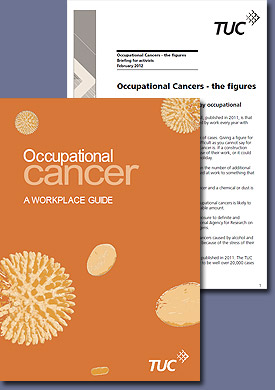 |
 |
|
TUC Issues Update To Occupational Cancers Guide The TUC's update to its existing guide into occupational cancers, provides interesting whilst alarming facts. Cancers caused workplace activities and exposure to carcinogens kill, one person in the UK every 30 minutes. The report entitled, 'Occupational cancer - a workplace guide' says the prevention of workplace cancers has a much lower profile in the workplace than preventing injuries, 'despite the fact that only 220 to 250 workers die each year as a result of an immediate injury as opposed to the 15,000 to 18,000 that die from cancer.' The TUC is calling for greater efforts to prevent cancers, through removing the cause from the workplace, better standards and enforcement and greater union involvement in finding solutions. The TUC's website page, Occupational Cancers - the figures provides some detail as to the scale of the risk of cancer faced by workers everyday taken from its document entitled 'Occupational Cancers - the figures' 'The most recent estimate published by the HSE, published in 2011, is that around 13,500 new cases of cancer are caused by work every year with over 8,000 deaths. This however underestimates the true number of cases. Giving a figure for what causes any kind of cancer can be very difficult as you cannot say for certainly what the cause of anyone's specific cancer is. If a construction worker develops skin cancer it could be because of their work, or it could be because of exposure to the sun when on holiday. That is why any figures are estimates, based on the number of additional cases of cancer among people who are exposed at work to something that is known to cause cancer.' But it warns that the scale of the problem can only be estimated because, 'Also sometime the link between a specific cancer and a chemical or dust is only suspected and has not been proven yet. Therefore, any estimate of the number of occupational cancers is likely to be an underestimation, possibly by a considerable amount.' The article continues, 'The HSE figures are based on estimates of exposure to definite and probable carcinogens defined by the International Agency for Research on Cancer and do not include suspected carcinogens. The figures also do not include deaths from cancers caused by alcohol and tobacco amongst people who drink or smoke because of the stress of their work........ The TUC has estimated that the true level is more likely to be well over 20,000 cases a year.' You can download the TUC guide to occupational cancers and the document containing 'the figures' from the E-Library Database here, by choosing the category 'Cancer (work related)' Source: TUC / Risks / |
|
|
